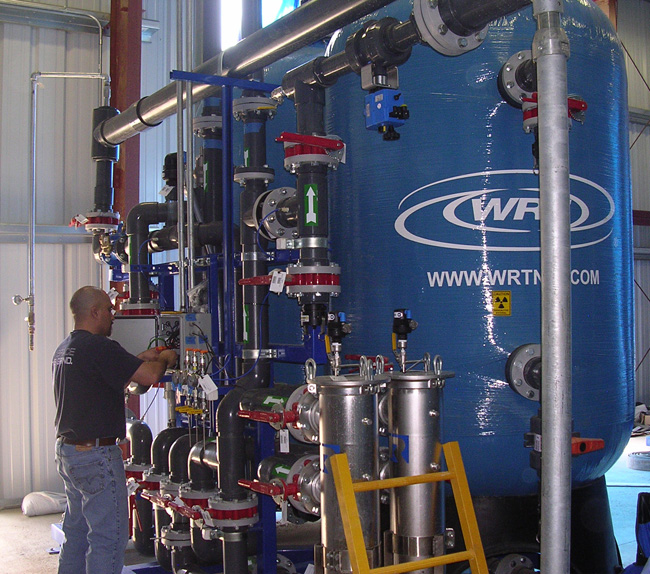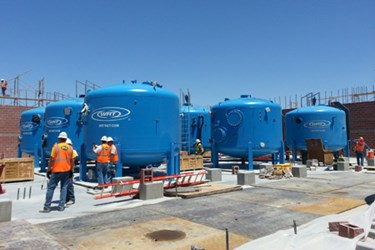5 Burning Questions On Uranium And Radium Removal
High levels of radionuclides (uranium/radium/etc.) in drinking water aren’t very common, but they are very dangerous. As carcinogens, these contaminants are strictly regulated by the U.S. EPA; every utility must monitor and provide adequate treatment in accordance with the federal rule, established in 1976 and revised in 2000.
If you’ve long dealt with radionuclides, you’re familiar with the treatment requirements — but are you treating as cost effectively as possible? Or perhaps you’re new to treatment, forced to use contaminated groundwater because alternative sources have dried up. In either case, a vetting process must be applied to ensure you’re getting the most out of your treatment. Ron Dollar of WRT - Water Remediation Technology, LLC provides guidance by addressing five key questions utilities should consider when choosing a system.
What are the different treatment options for radionuclides found in groundwater?
Generally speaking, the treatment methods that are available for this application are: conventional ion exchange; hydrous manganese oxide (HMO); absorbent media (Z-88®/Z-82®); reverse osmosis (RO); and lime softening. [See the presentation below for descriptions and comparisons presented by WRT.]
The other common solution is to seek alternative water sources. Sometimes drilling a new well seems like a good solution, but the acquisition, development, and infrastructure costs may exceed the life-cycle treatment cost.
What are the cost differences and factors associated with treatment?
Taking radium or uranium out of the water isn't that difficult. It's the operating cost and dealing with the treatment residuals that makes the difference. If you can send your treatment residuals to a sanitary sewer, it's pretty inexpensive. But fewer and fewer States are allowing that to occur.
If you have a treatment process that produces radioactive treatment residuals, and those aren’t allowed to be discharged to the sanitary sewer, then there's no good way to deal with it. There are no liquid disposal sites for this material, so you really have to look at changing to a different treatment process.
With WRT’s absorbent media treatment process, the radium or uranium winds up in the treatment media, which subsequently gets removed as a granular solid. It’s classified as low-level radioactive waste, and there are specific sites licensed to receive this material. A Radioactive Material License is required to handle this material. WRT has the infrastructure in place to handle all of the licensing and disposal of radioactive treatment residuals. We have about 150 treatment systems currently in operation, in 19 different States.
How does WRT media differ from other treatment media?
Other media types need to be regenerated and backwashed, which produces a liquid waste stream. The only way to avoid the waste stream is by not backwashing and regenerating. This is economically unfeasible because the media would only last a very short time before needing to be replaced.
We manufacture our own proprietary treatment media, formulated specifically for these applications, to be as cost efficient as possible, while removing the contaminant from the water and the local environment. A conventional anion or cation exchange media could be utilized to remove a number of contaminants and not formulated, necessarily, just for radium or uranium.
By putting together the infrastructure to handle the waste material and by formulating our own treatment media, we’re able to do it cost effectively. We have all the pieces in place.

What about the environmental ramifications of treatment?
When you pump the water out of the ground into our treatment system, we capture the radium or uranium immediately and remove it from the water cycle completely. By contrast, sewer disposal just passes the problem along through the collection system and to the wastewater treatment facility. Even when it leaves the wastewater treatment plant, you're sending the radionuclides back into the local environment.
WRT actually has the ability to take the used uranium media to a processor, remove the uranium, and put it back into the fuel cycle. It eliminates the disposal step, and there’s zero waste.
There’s no beneficial use for radium, unfortunately, so it needs to be disposed of. But we have long-term service agreements with sites that can take that material; we prepare, package, and safely deliver it to those sites.
If you’re regenerating media and sending your radioactive treatment residuals to the wastewater plant, you really didn't solve the problem — you just handed it off downstream to the next guy. And it gets there, of course, through the sanitary sewer, which runs all through the City. Anytime you have a leak or backup or maintenance issue, you're allowing exposure to that radioactive material.
What is the life-expectancy for typical treatment systems? If systems were installed in the early 2000s — in response to the EPA’s mandate — would it be time to upgrade?
When you look at capital equipment in the water industry, a typical useful life is 20 years. It doesn't mean that everything will last that long, but they tend to be capitalized over 20 years. We're not really there yet, with regard to the early 2000s, but some of those systems are already in need of upgrades. A number of conventional ion exchange systems designed to send treatment residuals to the sewer are getting retrofitted to no longer do so, or being replaced altogether.
There are also systems and States still achieving compliance, and new wells being drilled that will require treatment. Aquifers change, especially in drought conditions, and water levels move up and down. Areas that were in once in compliance may change over time and have compliance issues. From both a compliance and environmental standpoint, knowing what's known, we’re seeing a lot of systems that could benefit from updated technology.
For more information, visit WRT - Water Remediation Technology, LLC.
Copyright © 1996 - 2015, VertMarkets, Inc. All rights reserved. To subscribe or visit go to: http://www.wateronline.com
http://www.wateronline.com/doc/burning-questions-on-radium-and-uranium-removal-0001
